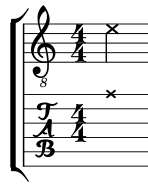| Revision as of 17:46, 19 April 2011 editBrumleygap (talk | contribs)230 editsmNo edit summary← Previous edit | Revision as of 17:58, 19 April 2011 edit undoBrumleygap (talk | contribs)230 edits added ghost note to See Also SectionNext edit → | ||
| Line 5: | Line 5: | ||
| == See also == | == See also == | ||
| * ] | * ] | ||
| * ] | |||
| {{Music-theory-stub}} | {{Music-theory-stub}} | ||
| {{WikiProject Music/Related WikiProjects}} | {{WikiProject Music/Related WikiProjects}} | ||
Revision as of 17:58, 19 April 2011

In music, a dead note, also known as a false note, has a rhythmic value, but no discernable pitch when played. On stringed instruments, this is played by sounding a muted string. In musical notation, this is represented by an "X" or a note head in parentheses.
See also
This music theory article is a stub. You can help Misplaced Pages by expanding it. |